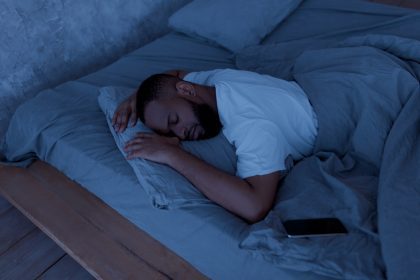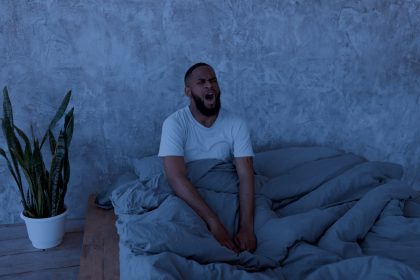Research-backed solutions address the root causes of tossing and turning for lasting results
Those endless hours of tossing and turning. The frustration of watching the clock as minutes tick by. The exhaustion that follows a night of fragmented sleep. For millions of people, restless sleep has become an unwelcome nightly companion that affects everything from mood and cognitive function to physical health and longevity.
While occasional sleep disturbances are normal, persistent restlessness at night signals that something in your sleep environment or daily habits needs attention. The encouraging news is that sleep science has identified several remarkably effective yet simple adjustments that can transform sleep quality without medication or expensive interventions.
These evidence-based solutions address the most common underlying causes of restless sleep, working with your body’s natural sleep mechanisms rather than forcing sleep through artificial means. The result is not just more hours of sleep, but deeper, more restorative sleep that leaves you feeling genuinely refreshed.
The temperature adjustment technique
Few people realize that body temperature regulation plays a crucial role in sleep quality. Research consistently shows that a slight drop in core body temperature helps initiate and maintain sleep, while even minor overheating can trigger restlessness and frequent awakenings.
The optimal bedroom temperature for most adults falls between 65-68°F (18-20°C), significantly cooler than typical daytime settings. This cooler environment facilitates the natural temperature drop that signals your brain it’s time for sleep.
Beyond room temperature, consider these targeted adjustments:
Layered bedding that can be easily adjusted during the night allows for temperature regulation without fully waking. Choose breathable natural fabrics like cotton, bamboo, or linen that wick moisture away from the body.
Cooling mattress toppers or pads can significantly improve sleep for those who tend to sleep hot. These range from simple gel-infused options to sophisticated systems with adjustable temperatures.
A warm shower or bath 60-90 minutes before bedtime paradoxically improves sleep by triggering a compensatory drop in core temperature afterward. The key is timing—bathing too close to bedtime can have the opposite effect.
Wearing socks to bed improves temperature regulation for many people. Research shows that warming the feet helps dilate blood vessels, redistributing heat throughout the body and facilitating the core temperature drop needed for quality sleep.
For those who share a bed with a partner who prefers different temperatures, dual-zone bedding or separate blankets can prevent temperature-related sleep disruptions without compromising closeness.
The temperature solution works by aligning your sleep environment with your body’s natural thermoregulation processes. Most people who implement these adjustments notice improvements within the first few nights, particularly in sleep initiation and middle-of-the-night awakenings.
The strategic light management system
Our sleep-wake cycles are fundamentally controlled by light exposure through its effects on melatonin production. Modern lifestyles with artificial lighting and screens have disrupted this ancient system, but strategic light management can restore its proper function.
This approach involves both daytime and nighttime light adjustments:
Morning sunlight exposure for 10-15 minutes within an hour of waking helps reset your circadian rhythm. This morning light signals your brain to fully suppress melatonin production, establishing a strong wake-sleep pattern.
Daytime brightness matters almost as much as nighttime darkness. Exposure to bright, natural light throughout the day strengthens circadian signals and improves nighttime melatonin production.
Evening light reduction beginning 2-3 hours before bedtime signals your brain to begin melatonin production. Dim household lights and consider using warm-toned bulbs in bedside lamps.
Electronic devices emit blue wavelength light that particularly disrupts melatonin synthesis. Use night modes on devices, wear blue-blocking glasses in the evening, or ideally, establish a complete electronic sundown one hour before bed.
Complete darkness for sleep is ideal. Use blackout curtains to eliminate outdoor light pollution, cover electronic displays in the bedroom, and consider a comfortable sleep mask if complete darkness isn’t otherwise achievable.
Red-spectrum night lights are the best option if you need illumination for nighttime bathroom visits. This wavelength minimally impacts melatonin production compared to white or blue light.
This comprehensive light management approach addresses one of the most fundamental biological signals for sleep. Most people experience significant improvements in both falling asleep and sleep continuity within one week of implementing these changes, with benefits continuing to accumulate over time.
The rhythm restoration protocol
Our bodies function optimally when operating on consistent schedules. Irregular sleep-wake patterns confuse the internal biological clock and contribute significantly to restless sleep. Restoring natural rhythms can yield remarkable improvements in sleep quality.
The most effective rhythm interventions include:
Consistent sleep and wake times, even on weekends. While occasional deviations are inevitable, keeping these times within a one-hour range reinforces your body’s natural cycles. This consistency helps regulate the production of sleep-related hormones and neurotransmitters.
A wind-down routine that begins 30-60 minutes before bedtime sends reliable signals to your brain that sleep is approaching. This might include gentle stretching, reading physical books, journaling, or other calming activities performed in the same sequence each night.
Regular mealtimes support healthy sleep patterns. Try to finish your last substantial meal at least 3 hours before bedtime, as digestion can interfere with sleep quality. If evening hunger disrupts your sleep, a small protein-rich snack 30 minutes before bed can help maintain stable blood sugar through the night.
Exercise timing affects sleep architecture. While regular physical activity significantly improves sleep quality, intense exercise within 1-2 hours of bedtime can be stimulating for many people. Morning or early afternoon exercise typically provides the greatest sleep benefits.
Caffeine curfews are essential for rhythm-sensitive individuals. Caffeine has a half-life of approximately 6 hours in most adults, meaning that afternoon consumption can still affect sleep quality. Consider establishing a caffeine cutoff time of 12-2 PM.
Even the timing of shower or bath routines can influence sleep patterns. Evening bathing signals the transition toward sleep for many people, while morning showers can serve as a powerful awakening cue.
The rhythm restoration approach works by reinforcing your body’s internal timekeeping system, synchronizing various physiological processes that impact sleep quality. Most people notice substantial improvements within 10-14 days of establishing more consistent daily patterns, with benefits continuing to develop over several weeks.
The breathing and relaxation method
Hyperarousal—a state of elevated physical or mental activation—is one of the most common yet overlooked causes of restless sleep. This physiological state can persist even when you feel subjectively tired, keeping your nervous system in a vigilant mode incompatible with deep sleep.
Evidence-based relaxation techniques can effectively shift your body from this alert state to one that facilitates restful sleep:
The 4-7-8 breathing pattern has shown remarkable effectiveness for sleep initiation. Inhale quietly through your nose for 4 seconds, hold the breath for 7 seconds, then exhale completely through your mouth for 8 seconds. Repeat this cycle 4 times initially, gradually working up to 8 repetitions. This pattern activates the parasympathetic nervous system, countering the stress response that often underlies sleep difficulties.
Body scanning involves systematically relaxing each part of your body from toes to head. Spend 15-20 seconds on each body region, consciously releasing any tension you discover. This practice not only relaxes muscles but also redirects attention away from racing thoughts.
White noise or pink noise creates a consistent sound environment that masks disruptive sounds and provides a focusing element for the mind. Research shows these steady background sounds can improve sleep quality by reducing the arousal response to environmental noises.
Guided sleep meditations that focus on progressive relaxation or visualization help transition the mind from active thinking to the passive awareness that precedes sleep. These can be particularly helpful for those whose restless sleep stems primarily from mental activity rather than physical discomfort.
Gentle stretching focused specifically on areas that tend to hold tension—typically the neck, shoulders, and lower back—can release physical stress that contributes to restlessness. A sequence of 4-5 simple stretches held for 30 seconds each can significantly reduce physical hyperarousal.
The relaxation approach directly addresses the physiological state that prevents many people from accessing deeper sleep stages. Because these techniques work on the nervous system level, many people experience improvements from the very first night, with effects strengthening through consistent practice.
The sleep environment optimization
Your bedroom serves as mission control for sleep quality, yet many people underestimate how significantly environmental factors influence restlessness. Research demonstrates that even subtle aspects of your sleep environment can either support or undermine sleep continuity.
Key optimization strategies include:
Mattress suitability significantly impacts sleep movements. Most mattresses have a useful life of 7-10 years, after which they may no longer provide proper support. The ideal firmness varies based on sleep position and body weight, but a mattress should maintain spinal alignment while relieving pressure points. Those who experience restlessness might benefit from materials that isolate movement, particularly when sharing a bed.
Pillow alignment can resolve many issues related to nighttime discomfort. Side sleepers typically need thicker pillows that maintain neck alignment, while back sleepers require thinner support. Stomach sleepers may benefit from very minimal pillow support or specially designed wedge systems. Additional pillow placement can also reduce restlessness—a pillow between the knees for side sleepers or under the knees for back sleepers often prevents the positional discomfort that triggers tossing and turning.
Air quality plays a surprisingly important role in sleep continuity. Dust, allergens, and inadequate oxygen levels can trigger micro-arousals throughout the night without fully waking you. Regular replacement of air filters, use of non-toxic bedding materials, and keeping bedroom windows slightly open when climate permits can significantly improve sleep breathing patterns.
Noise elimination goes beyond obvious disruptions like traffic or loud neighbors. Even subtle sounds like a ticking clock, a partner’s breathing, or the hum of electronics can trigger subconscious arousal responses. Consider using white noise machines, fans, or ear plugs to create a more consistent sound environment.
Bedroom clutter creates subconscious stimulation that can interfere with the brain’s ability to downshift into sleep mode. Research suggests that a visually calm environment promotes the mental quieting necessary for deep sleep. Removing work materials, exercise equipment, and electronic devices helps designate the bedroom as a space dedicated primarily to rest.
The sense of security plays a fundamental role in sleep quality. Ensure that basic safety measures like functioning smoke detectors and secured entrances are in place, as even subconscious safety concerns can contribute to vigilant, light sleep.
The environmental approach addresses the external factors that can repeatedly disturb sleep without completely waking you. While some elements require initial investment, these improvements typically provide lasting benefits to sleep quality. Many people report significant reductions in restlessness within the first few nights after optimizing their sleep environment.
Implementing these solutions effectively
While each of these approaches can significantly improve sleep on its own, their combined effect is often transformative. Consider implementing them in this strategic sequence:
Week 1: Begin with temperature adjustments and light management, as these address the most fundamental biological sleep mechanisms.
Week 2: Add rhythm restoration elements, particularly consistent wake times and a pre-sleep routine.
Week 3: Incorporate the breathing and relaxation techniques while beginning to address environmental factors that may require more time to modify.
This gradual implementation prevents the overwhelm that can come from trying to change too many habits simultaneously. It also allows you to identify which interventions provide the greatest benefit for your particular sleep challenges.
Track your results with a simple sleep journal noting bedtime, wake time, number of remembered awakenings, and subjective sleep quality. This record helps identify patterns and confirms improvements that might otherwise go unnoticed.
For those whose restless sleep persists despite implementing these strategies consistently for several weeks, consider consulting a sleep specialist. Certain medical conditions like sleep apnea, periodic limb movement disorder, or restless leg syndrome may require specific interventions beyond these general approaches.
The most encouraging aspect of addressing restless sleep through these methods is that improvements tend to build upon themselves. Better sleep leads to more balanced daytime energy, which supports healthier habits, which in turn promotes better sleep—creating a positive cycle that can substantially improve quality of life.
By addressing the foundational elements of healthy sleep architecture, these strategies don’t just add more hours to your sleep; they enhance the quality of that sleep, allowing your body to move properly through the various sleep stages essential for physical restoration, emotional processing, and cognitive function. The result isn’t just less tossing and turning, but a deeper, more restorative sleep experience that serves as the foundation for vibrant waking life.


















